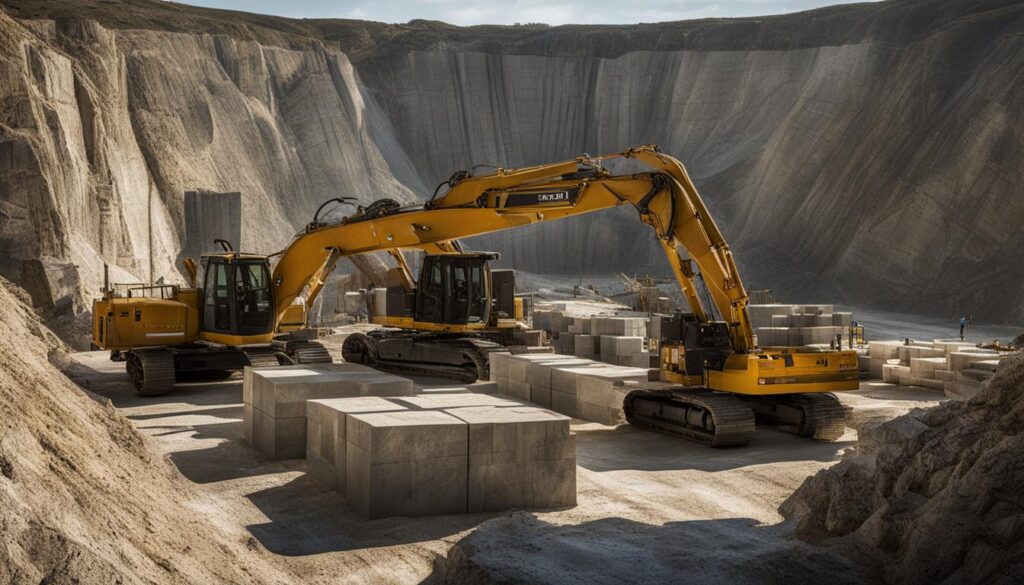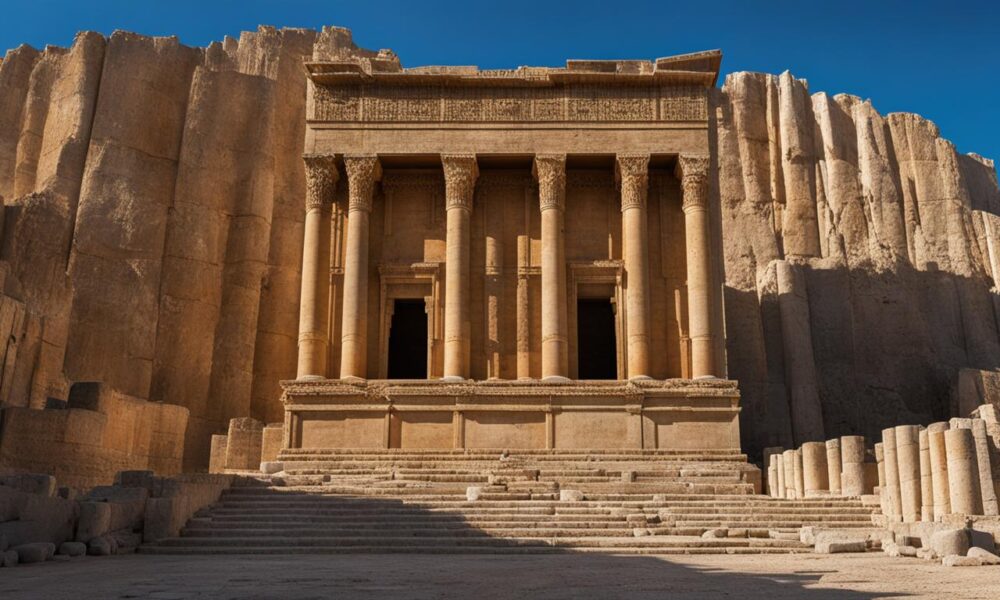Discover the World’s Biggest Natural Stone!
Prepare to be amazed by the sheer grandeur of the Baalbek Stones in Lebanon. These colossal rock formations are a testament to the remarkable feats of ancient craftsmanship and engineering. Among them, the Baalbek Stones boast the largest natural rock formation ever quarried by human hands, making them a true wonder of the world.
As you explore the rich history of these megalithic structures, prepare to be awe-struck by their massive scale and intricate details. The largest stone, aptly named the “Forgotten Stone,” weighs an astounding 1,650 tons, solidifying its place as the biggest natural stone in the world. It stands as a testament to the ingenuity and skill of the ancient Romans.
Let’s dive deeper into the remarkable Baalbek Stones and uncover the mysteries that surround them.
Key Takeaways:
- The Baalbek Stones in Lebanon are home to the world’s largest natural rock formation ever quarried by human hands.
- The Forgotten Stone, weighing 1,650 tons, takes the crown as the biggest natural stone in the world.
- These monumental rock structures showcase the awe-inspiring craftsmanship and engineering skills of the ancient Romans.
- Exploring the Baalbek Stones unravels the mysteries and secrets surrounding their construction.
- Archaeological investigations and ongoing research shed new light on the historical significance of these natural wonders.
The Baalbek Stones – A Monumental Geological Wonder
The Baalbek Stones in Baalbek, Lebanon, are not just any rocks. They are monumental geological wonders that leave visitors in awe of their massive size and incredible craftsmanship. These massive rock formations stand as epic natural stone landmarks, showcasing the architectural brilliance of the ancient Romans.
The Baalbek Stones include the famous Trilithon, a trio of massive stones estimated to weigh around 750-800 tons each. These colossal rock formations serve as a testament to the engineering genius of their creators.
However, the Trilithon is not the only marvel at Baalbek. Three imposing Roman monoliths add to the grandeur of the site. The Stone of the Pregnant Woman, the Stone of the South, and the Forgotten Stone each weigh over 1,000 tons, making them truly extraordinary examples of ancient stone craftsmanship and engineering.
Baalbek Stones
| Stone | Weight (tons) |
|---|---|
| Trilithon | 750-800 |
| Stone of the Pregnant Woman | Over 1,000 |
| Stone of the South | Over 1,000 |
| Forgotten Stone | Over 1,000 |
These massive rock formations, etched with intricate details, stand as everlasting testaments to the ancient world’s architectural achievements. As visitors explore Baalbek, they are transported back in time, marveling at these wonders of nature and human ingenuity.
“The Baalbek Stones are not only fascinating geological formations but also historical treasures that contribute to our understanding of ancient civilizations.” – Archaeologist Dr. Sarah Roberts
Exploring the Baalbek Stones is an experience like no other. Standing in their presence, surrounded by the remnants of an ancient civilization, one cannot help but feel a deep sense of wonder and awe. These monumental geological wonders continue to captivate the world with their sheer size and timeless beauty.
The Stone of the Pregnant Woman – A Remarkable Stone Formation
The Stone of the Pregnant Woman is one of the most impressive stone sculptures among the Baalbek Stones in Lebanon. This monolith, estimated to weigh 1,000 tons, showcases the remarkable craftsmanship and engineering prowess of the ancient Romans. Its colossal size and fine condition make it a captivating sight for visitors.
Measuring approximately 20.31-20.76 meters in length, 4 meters wide at the base, and 4.21-4.32 meters high, the Stone of the Pregnant Woman stands as one of the largest known stones ever quarried. Its imposing angle and detailed workmanship leave spectators in awe.
What sets this stone apart is its unique visibility. Unlike its counterparts, the Stone of the Pregnant Woman has never been fully hidden by earth. Standing proudly in plain view, it serves as a testament to the skill and determination of the ancient quarrymen.
Its presence has raised questions and sparked curiosity among archaeologists and historians. How was this colossal stone carved and transported? What significance did it hold in the ancient Roman world? The Stone of the Pregnant Woman continues to be a subject of study and admiration, captivating all who encounter its grandeur.
Impressive Dimensions of the Stone of the Pregnant Woman:
| Measurements | Approximate Dimensions |
|---|---|
| Length | 20.31-20.76 meters |
| Width (Base) | 4 meters |
| Height | 4.21-4.32 meters |
| Weight | 1,000 tons |
The Stone of the South – A Massive Rock Formation
The Stone of the South, also known as the Second Monolith, is an impressive Roman monolith that weighs an estimated 1,242 tons. It measures approximately 19.5-20.5 meters long, 4.34-4.56 meters wide, and 4.5 meters high, making it one of the largest stones ever quarried.
This colossal rock formation was rediscovered in the same ancient quarry as the other Baalbek Stones, adding to the awe-inspiring collection of monumental structures. It is believed that the Stone of the South was intended for the Jupiter Baal complex, showcasing the ambitious architectural plans of the ancient Romans.
Surpassing the size of the Stone of the Pregnant Woman, the Stone of the South stands as a testament to the incredible craftsmanship and engineering skill of the builders. Its massive proportions continue to astound archaeologists and visitors alike, offering a glimpse into the monumental achievements of the past.

| Stone Name | Weight (tons) | Length (meters) | Width (meters) | Height (meters) |
|---|---|---|---|---|
| Stone of the South | 1,242 | 19.5-20.5 | 4.34-4.56 | 4.5 |
The Forgotten Stone – The Largest Stone Ever Quarried
Discovered in 2014, the Forgotten Stone, also known as the Third Monolith, has captivated archaeologists and researchers with its colossal size. Weighing approximately 1,650 tons, this monumental stone block is considered the largest stone ever quarried in human history. It measures around 19.6 meters long, 6 meters wide, and at least 5.5 meters high.
Located in an ancient quarry, the Forgotten Stone is currently the subject of ongoing study. Researchers aim to unravel the mysteries surrounding its unfinished state and investigate the techniques employed to transport such an enormous block of stone. This ambitious endeavor will provide invaluable insights into the ancient quarrying methods used by our ancestors.
“The Forgotten Stone stands as a remarkable testament to human engineering prowess and the immense dedication required to work with such monumental stone blocks.”
By analyzing the Forgotten Stone and comparing it to the other Baalbek Stones, experts hope to shed light on the remarkable achievements of the ancient Romans in quarrying and construction. The examination of this unparalleled artifact will not only deepen our understanding of ancient civilizations but also inspire awe at the magnitude of their architectural prowess.
| Attributes | Measurements |
|---|---|
| Length | Approximately 19.6 meters |
| Width | Approximately 6 meters |
| Height | At least 5.5 meters |
| Weight | Approximately 1,650 tons |
The Forgotten Stone stands as a testament to the ingenuity and perseverance of ancient civilizations. Its massive size and the level of craftsmanship required to work with such a monumental stone block continue to awe and inspire researchers and visitors alike. As ongoing studies unravel its secrets, the Forgotten Stone offers invaluable insights into our shared human history and the remarkable achievements of our ancestors.
The Trilithon – A Marvel of Ancient Architecture
The Trilithon, a group of three horizontally lying giant stones, is a magnificent architectural wonder that forms part of the podium of the Temple of Jupiter Baal in Baalbek. These massive stones, weighing around 750-800 tons each, are approximately 19 meters long, 4.2 meters high, and 3.6 meters thick. They serve as a testament to the ancient architectural records and engineering prowess of the Romans during the early Byzantine period.
The Trilithon’s precise construction and alignment reflect the exceptional craftsmanship and attention to detail of the ancient builders. Each stone is meticulously carved and positioned to create a sense of grandeur and strength. The impressive size and scale of the Trilithon make it an awe-inspiring sight and a testament to the ingenuity of ancient civilizations.
“The Trilithon stands as a testament to the ingenuity and architectural mastery of the ancient Romans. Its massive size and precise placement demonstrate their exceptional engineering skills.”
The Temple of Jupiter Baal
The Trilithon holds a place of significance within the Temple of Jupiter Baal, an ancient religious complex dedicated to the Roman god Jupiter. This temple, known for its colossal proportions, was one of the largest religious structures of the ancient world. The Trilithon’s presence within this sacred site further exemplifies its importance in both religious and architectural contexts.
| Length | Height | Thickness | Weight | |
|---|---|---|---|---|
| Trilithon Stones | Approximately 19 meters | 4.2 meters | 3.6 meters | 750-800 tons |
The Trilithon’s colossal scale and precise positioning within the Temple of Jupiter Baal showcase the architectural achievements of the ancient Romans. As the centerpiece of this magnificent structure, it continues to captivate visitors and researchers alike, sparking curiosity about the construction techniques employed and the significance of this architectural marvel.
Uncovering the Mystery of Quarrying Techniques
The quarrying techniques and methods used in ancient Roman construction to mine and transport the massive Baalbek Stones are still shrouded in mystery. Archaeologists continue to research and debate these techniques to gain a deeper understanding of the engineering prowess of the Romans.
Through a meticulous study of the machining marks and excavation sites, researchers aim to unravel the process of extracting and moving these colossal stones. Their findings provide valuable insights into the ingenuity behind the construction of these monumental geological wonders.
One intriguing aspect of the quarrying techniques is the discovery of monoliths, such as the Hajjar al-Hibla, with poor quality stone edges. This observation raises questions about why some stones were left in the quarry and not used in the construction.
“Studying the quarrying techniques used by the ancient Romans allows us to reconstruct their methods and appreciate their remarkable achievements in construction,” says Dr. Maria Lopez, a leading archaeologist working on the Baalbek Stones.
The study of ancient Roman construction techniques not only sheds light on the technology and craftsmanship of the time but also provides valuable insights into the social and economic aspects of ancient civilizations. By peering into the quarrying techniques of the Baalbek Stones, researchers can gain a better understanding of the extraordinary achievements of the Roman Empire.
Ancient Quarrying Techniques
The quarrying techniques employed by the Romans involved a combination of manual labor and ingenious engineering. The process generally began with the identification of suitable stone formations in the vicinity of the construction site.
- Mining and Excavation: Once the stone formations were identified, miners would extract the stones using picks, chisels, and wedges. They would create channels and grooves to weaken the rock and facilitate the extraction process.
- Transportation Methods: The transportation of the massive stones from the quarry to the construction site required ingenious methods. Researchers believe that ancient Romans employed various techniques, including the use of sledges, ramps, and possibly even large wooden cranes.
- Quarrying Tools: The tools used for quarrying included hammers, chisels, pickaxes, wedges, and saws. These tools were made of durable materials such as iron and bronze, allowing the workers to precisely shape and cut the stones.
The quarrying techniques employed by the ancient Romans were incredibly sophisticated for their time, showcasing their mastery of engineering and construction. These techniques were crucial in the creation of monumental structures like the Baalbek Stones, which continue to awe and inspire to this day.

Quarrying Techniques: A Continuing Puzzle
Despite extensive research and exploration, the quarrying techniques used to extract and transport the Baalbek Stones remain a subject of ongoing investigation. Archaeologists and experts continue to analyze the available evidence, hoping to unlock further clues about these enigmatic methods.
The study of quarrying techniques provides valuable insights not only into ancient Roman construction but also into the resource management, labor organization, and technological advancements prevalent during that era. By piecing together the puzzle of these techniques, researchers can paint a comprehensive picture of the monumental achievements of ancient civilizations.
Continuing Archaeological Expeditions at Baalbek
Baalbek has long captivated the attention of archaeological expeditions from around the world, with German and French groups at the forefront of exploration. Since the 19th century, these dedicated researchers have been tirelessly uncovering the secrets of the ancient Roman site, and their work continues to yield fascinating discoveries into the 21st century.
The ongoing research efforts at Baalbek involve extensive investigations and excavations aimed at shedding light on various aspects of the site. One area of focus is the monumental stone structures that have stood the test of time, captivating visitors with their grandeur. By carefully studying these structures, archaeologists hope to unravel the mysteries surrounding their construction techniques and gain insights into the skills and engineering prowess of the ancient Romans.
In addition to studying the stone structures, the expeditions also aim to delve deeper into the historical significance of the Baalbek Stones. Through meticulous analysis of artifacts, inscriptions, and other archaeological evidence, researchers hope to gain a better understanding of the purpose and cultural context of these ancient marvels. The ongoing research at Baalbek is an exciting endeavor that continues to push the boundaries of knowledge in the field of archaeology.
Key Findings from Recent Expeditions
“Our recent expeditions have revealed fascinating new insights into the quarrying techniques used by the ancient Romans. Through careful examination of the machining marks on the stones and the excavation sites, we have gained a clearer understanding of how these massive blocks were extracted and transported,” explains Dr. Anna Schmidt, lead archaeologist of the German expedition.
The collaborative efforts of researchers have led to remarkable discoveries and groundbreaking conclusions. These findings not only contribute to our knowledge of ancient civilizations but also help us appreciate the ingenuity and skill of those who came before us.
Archaeological Expeditions at Baalbek: Historical Timeline
| Year | Expedition Group | Significant Discoveries |
|---|---|---|
| 1852-1854 | French expedition led by Ernest Renan | Initial documentation and exploration of the site |
| 1898-1903 | German expedition led by Theodor Wiegand | Excavation and identification of the Temple of Jupiter Baal and surrounding structures |
| 2010-Present | Collaborative efforts between German and French groups | New insights into quarrying techniques and continued exploration |
The table above provides a brief overview of the notable archaeological expeditions at Baalbek throughout history. It highlights the dedication of researchers from different nations and their contributions to our understanding of this historic site.
As ongoing research and excavations continue to unfold at Baalbek, there is no doubt that further discoveries and revelations are yet to come. The commitment of archaeological teams ensures that the story of Baalbek will be preserved and shared with future generations, allowing us to marvel at the monumental wonders of the past.
The Significance and Mystery of the Baalbek Stones
The Baalbek Stones hold great historical significance and are steeped in ancient mysteries. These monumental structures have captivated the attention of archaeologists and researchers for centuries, as they represent a remarkable feat of engineering and craftsmanship.
The Baalbek archaeological site is home to these massive stone formations, showcasing the grandeur of ancient Roman construction techniques. However, the purpose and exact methods behind the creation and transportation of these stones remain enigmatic, adding to their mystical allure.
“The Baalbek Stones stand as a testament to the ingenuity and skill of the ancient Romans, leaving us pondering their true purpose and the incredible effort that went into their creation.”
Continued exploration and study of the Baalbek site are crucial in unraveling the secrets concealed within these imposing structures. Archaeologists meticulously examine the stones, their placement, and the surrounding landscape to gain deeper insights into their historical significance and the motivations behind their construction.
By analyzing the quarrying techniques used and examining the evidence left behind, researchers hope to shed light on the immense logistical challenges involved in moving such massive stones over vast distances. The Baalbek Stones challenge our understanding of ancient technology and inspire further investigation into the capabilities of past civilizations.
As ongoing research and archaeological expeditions uncover new information, the Baalbek Stones continue to intrigue and captivate the imaginations of those who visit this extraordinary site.
| Key Aspects | Historical Significance | Ancient Mysteries | Baalbek Archaeological Site |
|---|---|---|---|
| Enigmatic purpose | X | X | |
| Imposing size | X | ||
| Meticulous craftsmanship | X | ||
| Quarrying techniques | X | ||
| Continued exploration | X |
Conclusion
The Baalbek Stones in Lebanon, including the Stone of the Pregnant Woman, the Stone of the South, and the Forgotten Stone, stand as remarkable examples of monumental geological wonders. With each stone weighing over 1,000 tons, these awe-inspiring rock formations exhibit the extraordinary skill and engineering prowess of the ancient Romans.
Ongoing archaeological expeditions and research at the Baalbek site are continuously uncovering new insights into the quarrying techniques and historical significance of these impressive stone structures. As researchers delve deeper into the mysteries surrounding the Baalbek Stones, they contribute to our understanding of the ancient world’s incredible architectural achievements.
The Baalbek Stones not only captivate the imagination but also hold immense cultural and historical importance. Through their preservation and study, we gain valuable insights into the past and expand our knowledge of ancient civilizations. The continued exploration of the Baalbek archaeological site promises to reveal even more about these monumental wonders and the people who created them.



